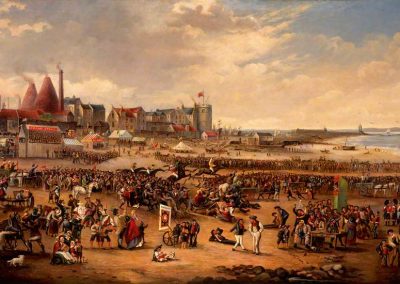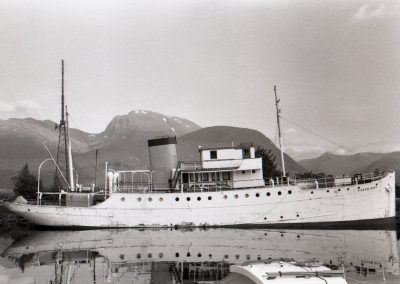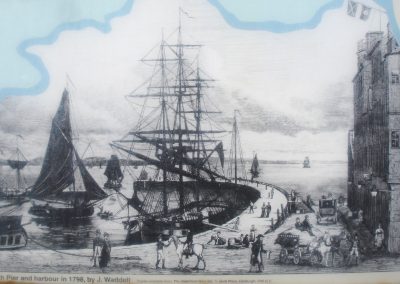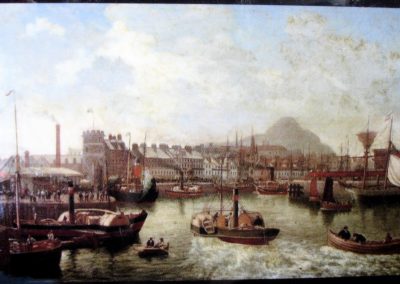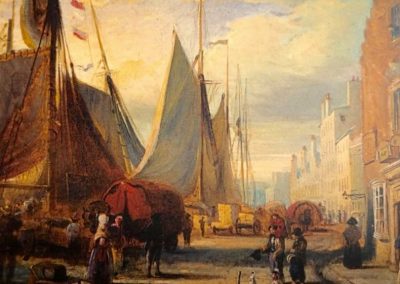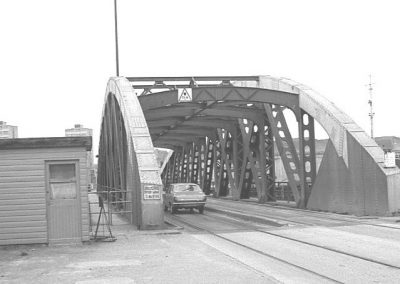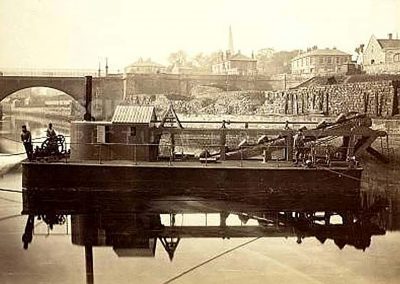Leith History
by FOWLB
Timeline
- 1900 The whale ships from Leith brought the first penguins to Edinburgh Zoo.
- 1904 The Imperial Dock opened.
1913 Leith Dockers strike for seven and a half weeks. - 1920 Leith merges with Edinburgh. At the referendum Leithers voted 5:1 against the merger. Leading the opposition to the merger was Captain William Benn, the Liberal Member of Parliament for Leith and father of the Labour Minister, Tony Benn.
- 1929 The foundation stone for a new Leith library was laid by the then Lord Provost.
- 1961 Leith library was finally completed.
- 1968 Freight services running on the railwayline along the Water of Leith were withdrawn and the lines uplifted.
1983 Henry Robb’s shipyard (Ocean Terminal) closed. - 1988 A small shipyard on Sheriff Brae, run by the Scottish Co-operative Society, closed, bringing to an end over 600 years of shipbuilding in Leith.
- 1995 The last whisky bond on Water Street was closed.
- 1801 The founding stone for the first wet dock was laid.
- 1805 The sails and domed roof of the windmill were removed and the building converted to a signal tower. Flag signals were employed to advise incoming ships of depth of the water.
- 1805 National Bank of Scotland built in Bernard Street.
- 1806 On 20 May the Lord Provost of Edinburgh, Magistrates (Baillies) and Council, along with a numerous company of ladies and gentleman processed for the opening of the first new Wet Dock north of Commercial Street, the first of its kind in Northern Britain.
- 1809 A Martello Tower was erected on Mussel Cape Rocks as part of a scheme to defend the new docks and the City of Edinburgh against possible attack during the Napoleonic Wars.
- 1809 The Exchange Buildings in Constitution Street built on the site of the Old Assembly rooms, containing an assembly room and a large public newsroom.
- 1812 The Custom House was built at the North end of the lower drawbridge at Bernard Street.
- 1813 Mr. William Crawford founded his biscuit business in a small shop at the Shore.
- 1813 The first steamship to enter Leith ran excursions between Leith and Bo’ness.
- 1816 Trinity House in Kirkgate becomes a seamen’s refuge.
- 1817 Western wet dock completed, also north of Commercial Street. The Scottish Government building is now where the eastern and western docks were.
- 1818 Junction Bridge Constructed.
- 1818 Excise Office established in Tollbooth Wynd.
- 1819 Old tollbooth taken down and rebuilt.
- 1821 A regular steamship service starts from Leith to London.
- 1821 Inhabitants in Leith numbered 26.000.
- 1822 The first visit since 1650 of a reigning monarch, King George IV of Scotland. The Old Ship Hotel and King’s Landing were then given new names to mark the King’s visit. To greet the king was Sir Walter Scott, clad in tartan and wearing the kilt.
- 1822 William Turner made a sketchbook, The King’s visit to Edinburgh Sketchbook, now in the Tate Gallery.
- 1823 The last execution for piracy took place on Leith Sands.
- 1824 Work started on the eastern pier, extending it by 1500 feet, giving a total length of 2500 feet. The western pier and breakwater were created and part of the Queen’s dock was used as a naval storage yard.
- 1827 The Court House and Town Hall erected on the corner of Constitution Street and Charlotte Street. To house the Town Council, Sheriff Court, Police Court and the police establishment.
- 1833 Leith was constituted an independent parliamentary burgh by William IV. At that time there were numerous Consulates in Leith; Belgium, Brazil, Chile, Denmark, France, Germany, Greece, Italy, the Netherlands, Portugal, Russia, Spain, Sweden and Norway, Turkey and Uruguay.
- 1834 The last whale was caught in the Firth of Forth.
- 1836 The General Steam Navigation Company was formed in Leith.
- 1837 Robert Menzies and Sons built the steamship Sirius, the first steamship to cross the Atlantic. Sirius was the first iron vessel to be registered in Lloyds.
- 1838 By an act of parliament the petty customs of the town were transferred from the city of Edinburgh to the Town Council of Leith.
- 1840 St Thomas’s Church, Manse, Schoolhouse and Asylum on Sheriff Brae were built by Sir John Gladstone of Fasque.
- 1842 Whaling ceased from Leith.
- 1848 The Tidal Harbours’ Commission report published. It emphasises the need for a deep water entrance to the harbour channel.
- 1851 Inhabitants in Leith numbered 30.676.
- 1852 The Victoria Dock was opened. The first vessel to enter it was the Royal Victoria, a steamer trading between Leith and London. This dock lies immediately to the north of the Wet Dock, and is now ornamental water to the side of the Scottish Government building.
- 1852 Leith Hospital opened in Mill Lane by public subscription.
- 1855 Leith Nautical College was established in Commercial Street.
- 1862 The Corn Exchange was built in Baltic Street with a corn hall 110 feet long by 70 feet broad.
- 1862 The Slaughter House was built in Salamander Street.
- 1867 Leith Royal Music Hall opens on the corner of St Andrew Street and Tollbooth Wynd.
- 1868 Rose’s Lime Juice was founded by Lachlan Rose in Leith on Commercial Street primarily to provide vitamin C to seamen.
- 1869 The Albert Dock opened.
- 1871 The Union Bank built in Bernard Street.
- 1874 The hydraulically-operated Victoria Swing Bridge across the Inner Harbour, linking the Albert Dock to the Victoria Dock, was completed. It was the largest in the United Kingdom.
- 1875 The new Post Office opened on corner of Constitution Street and Mitchell Street.
- 1877 Construction of a stone sea wall from Albert dock to the Seafield Toll completed.
- 1881 The Edinburgh Dock opened.
- 1885 The Henderson Street Improvement Scheme launched, resulting in loss of several historic buildings.
- 1885 Seamen’s hostel, now Hotel Malmaison, opened.
- 1881 The inhabitants in Leith numbered 55.330.
- 1881 The Edinburgh Dock opened by the Duke of Edinburgh. Swing bridge built over the channel between the Edinburgh and Albert Dock.
- 1892 The inhabitants in Leith number almost 68,000.
- 1896 The Czar of Russia, Nicholas II, visits Leith.
- 1705 A captain and 3 seamen executed for piracy and murder.
- 1707 At the act of Union (by the Parliaments of Scotland and England) some 5,500 people lived in Leith.
- 1715 Bell Rannie and Company, importers of wine, was established. In their ledgers the wine bills run up by Bonnie Prince Charlie are to be found.
- 1720 The first dry dock in Scotland built at the western entrance to the harbour.
- 1730 A stone pier was built which extended the wooden pier by 300 feet. A small dock was also constructed on the west side of the river mouth.
- 1750 Edinburgh Roperie and Sailcloth Company was founded in Leith
- 1753 An act of Parliament ordered that the harbour be enlarged and deepened.
- 1757 The first sugar refinery, the Sugar House, was established by Edinburgh Bankers.
- 1760 Scotland’s largest lead works founded on the corner of Mitchell Street and Constitution Street.
- 1770 Edinburgh Crystal Company started in Baltic Street.
- 1773 Johnson and Boswell visit Leith. Boswell writes: He (Johnson) observed of the pier ’you have no occasion for so large a one; your trade does not require it but you are like a shopkeeper who takes a shop, not only for what he may put into it, but that it may be believed that he has a great deal to put into it’.
- 1774 A second dry dock constructed.
- 1777 A short pier known as the Custom House Quay was built.
- 1778 Abbot Ballantyne’s old stone bridge is demolished and replaced by a drawbridge further downstream.
- 1779 Leith Fort built to defend the harbour. It lies ½ mile west of the Customs House overlooking the shore. Initially a battery of 9 guns, but later became a large military barracks and the headquarters of the Royal Artillery in Scotland.
- 1780 The first public sewer in Scotland was built in Bernard Street; this flowed into the Water of Leith.
- 1783 Assembly Rooms built in Constitution Street.
- 1785 Messrs. J. G. Thomson began business in the Vaults in Henderson Street. They raised the Vaults to their present height.
- 1788 Robert Whitworth, an engineer, designed a wet dock of 7 acres to be located near the Sheriff Brae.
- 1789 Reflector light is placed on pier head.
- 1789 Construction on a new Leith Dock begun.
- 1791 Inhabitants in Leith numbered 12.000.
- 1799 John Rennie, a civil engineer was employed to furnish designs for docks and extended piers suited to the growing requirements of trade.
- 1799 A party of Highland recruits which were to sail from Leith mutinied. 12 Highlanders were killed and 20 wounded.
- 1603 The Union of the Crowns (March 1603) was the accession of James VI, King of Scots, to the thrones of England and Ireland, and the consequential unification of Scotland with both realms under a single monarch.
- 1606 King’s Wark and the adjacent lands were gifted by James VI to Bernard Lindsay of Lochhill by an Act of Parliament. Within the site he built a tennis court. He was allowed to levy a tax on every tun of wine sold in the taverns in King’s Wark, of which there were never to be more than four. From this tax he was to erect in the King’s Wark a bourse or exchange for merchants “for the decorating of the pier and Shore of the haven of Leith”.
- 1607 St Mary’ Catholic Church, between Kirkgate and Constitution Street built.
- 1610 35 English sailors were hanged on the Sands of Leith for piracy.
- 1610 Lambs House, a 4 story tenement with booths on the ground floor and serviced apartmentson the upper floors built by Andro Lamb.
- 1614 King James’s Hospital founded east of Kirkgate.
- C1615 A new timber pier built (lasting 240 years).
- 1616 Whaling begins from Leith to Newfoundland.
- 1617 King James VI and I lands at Leith bound for Holyrood.
- 1619 A monopoly of soap-making was granted to Leith. This lasted for 21 years.
- 1620 Beacons erected on rocks for ship safety.
- 1622 Skirmishes between the Dutch and the Spanish. 3 warships in Leith Harbour.
- 1631 Lord Balmerino’s 4 floor mansion with a large garden was built in Charlotte Street.
- 1633 Charles I visits Scotland, landing in Leith.
- 1636 A Royal Charter finally established Leith a Burgh of Barony and Edinburgh’s superiority over all of Leith was reaffirmed.
- 1639 Edinburgh acquired North Leith from the Earl of Roxburgh.
- 1644 The area north of Bernard Street (now called Timberbush) was where goods, unloaded at the quays, were stored. James VI granted a charter to Bernard Lindsay (after whom the nearby Bernard Street is named) allowing him to build a paved piazza looking on to the harbour. The wooden fence enclosure was replaced by a strong stone wall with stone arches supported on columns “to be the ordinary Burse and walking place for merchants, natural & stranger.” This was a merchants’ exchange, quite in the continental manner. Later the whole ground was used as a timber market.
- 1645 The plague hit Leith carrying off two thirds of the population. Over 2700 died in South Leith.
- 1647 Kings Wark was acquired by Edinburgh burgh council.
- 1650 Charles II rides to Leith from Stirling. He stayed at Lord Balmerino’s mansion off Kirkgate.
- 1650 Major General Lambert occupies Leith with his troops, acting for Oliver Cromwell.
- 1656 After Cromwell’s victory at the Battle of Dunbar in 1650 and subsequent occupation of Scotland, a large fort known as Leith Citadel was erected by General Monk to regulate the port traffic. All that remains of the fort today is a vaulted gateway in Dock Street which was its main entrance.
- 1662 First Scottish glass factory in Leith.
- 1677 First sugar refinery established in Leith.
- 1680 Anchor soap works was established on Water Street.
- 1682 King James VII, while Duke of York, landed at Leith in order to play golf on the links.
- 1682 The oldest date for the Vaults in Henderson Street, when the great building, much lower than now, was either reconstructed or rebuilt. This building is locally known as the “Vouts,” a name which, in spelling and pronunciation, carries us back to the troubled days of Mary Queen of Scots.
- 1682 The Vaults rebuilt.
- 1685 The King’s Master Mason, Robert Milne, was granted land along the shore to build a sea wall to protect timber stores (now Timber Bush).
- 1685 Robert Milne builds a windmill tower on the Shore.
- C 1690 The Kings Wark destroyed by fire.
- 1698 The ill fated Darien expedition of 5 frigates with 1200 men and 300 gentlemen sailed from Leith Roads.
- 1502 Shipbuilding begins in Leith.
- 1537 Madeleine de Valois , first wife of James V, landed at Queen’s Landing.
- 1542 Mary Queen of Scots is born.
- 1543 Queen Mary is crowned at Stirling Castle. Her mother, Mary of Guise, ruled as Regent aided by Cardinal Beaton.
- 1544 The first serious attempt to improve the harbour was made by the Earl of Hertford, who having seized Leith, ordered a wooden pier to be constructed. On leaving Scotland for England he plundered the port and ordered the pier to be burnt so it might not benefit the Scots.
- 1544 The buildings at Kings Wark, which included the tower, were burnt during the war of the Rough Wooing after 80,000 cannon balls were looted by the English army.
- 1545 Sir Robert Logan of Restalrig used the tower as a Tollbooth for Leith.
- 1547 Leith sacked again by the Earl of Hertford, now Duke of Somerset and Lord Protector of England. The Duke carried off 35 vessels.
- 1548 French troops arrive in Leith by invitation of the Scots.
- 1548 Work on fortifying Leith begins.
- 1550 October 8th an act of the Lords of Session was confirmed against the inhabitants of North Leith, by which the Provost and bailies of Edinburgh were held proper judges of the said inhabitants in the petty customs of Leith belonging to the town of Edinburgh.
- 1554 Mary of Guise (Lorraine) became Queen Regent and ruled Scotland from Leith. She may have lived in a building at the head of Queen Street, formerly called Paunch Market, demolished in 1849. Alternatively she may have stayed in a house at the corner of Quality Wynd, in the Rotten Row. The Queen Regent is credited with the erection of a house, now demolished, on Coalhill in which her privy council met. This house is supposed to have been used successively by Mary of Lorraine, the Earl of Lennox and the Earl of Mar.
- 1554 The first bastion, called Ramsay’s Fort, situated on the east side of the river between the beach and present Bernard Street was intended to protect the harbour.
- 1555 Mary of Guise acting as Queen Regent promoted Leith to a Burgh of Barony. She purchased the superiority of the town from Sir Robert Logan for the benefit of the citizenry.
- 1559 Leith becomes a walled town. The rampart was octagonal in form, similar to Berwick upon Tweed, with a bastion at each of the eight angles. The first bastion was Ramsay’s Fort. The eighth bastion was at Sandport, overlooking the harbour. Between the fifth and sixth bastion flowed the river. The two parts were joined by a wooden bridge. The wall was built wholly of stone and was pierced by six gates or ports.
- 1559 John Knox landed from exile in Leith.
- 1560 At St Anthony’s Port, the main entrance to the town, severe fighting with some bloodshed took place when the Lords of the Congregation, assisted by the English, were badly defeated by the combined Scots and French forces under the standard of Mary of Guise and Lorraine.
- 1560 Mary of Guise, second wife of King James V of Scotland, dies.
- 1560 The Siege of Leith ended a twelve-year encampment of French troops leaving the port under English occupation.
- 1560 The Treaty of Edinburgh (also known as the Treaty of Leith) was drawn up on 5 July between the Commissioners of Queen Elizabeth of England with the assent of the Scottish Lords of the Congregation, and the French representatives of King Francis II of France (husband of Mary Queen of Scots) to formally conclude the Siege of Leith and replace the Auld Alliance with France with a new Anglo-Scottish accord, while maintaining the peace between England and France. The treaty of Leith was not ratified by Mary, Queen of Scots, the reigning monarch at the time, until Edinburgh seized Leith by force in 1567.
- 1560 After the signing of the Treaty of Leith the fortifications were partly dismantled.
- 1560 The Citadel of Leith on the north Leith side of the river was constructed by Oliver Cromwell’s forces. It was a large pentagonal construction with walls faced with hewn stone. It had five bastions, with barracks and a stone building for magazines and stores and also houses for the governor and officers. General Monck, who was Cromwell’s officer in charge of Scotland, closed the churches. He used the St James’ Hospital, the vaults under Trinity House and the old St Anthony’s Hospice for munitions stores. South Leith Church became stables for the horses and a store for the artillery. He destroyed the Old Hospice and church of St Nicholas as well as the burial ground of North Leith Parish Church – St Ninian’s. Only one gate, or port, remains on the west side of Dock Street
- 1561 Mary Queen of Scots arrives in Leith from France with two vessels and accompanying boats. She disembarked at ‘Queen’s Landing’ with her 3 uncles of the house of Guise, the son of the Constable of France and her gentlewomen, called the four Maries. She was received by Lord James, her natural brother and many of the chief nobility. She stayed and had supper at Andro Lamb’s house.
- 1565 The old tolbooth built (taken down in 1819).
- 1567 James, later king James VI of Scotland and James I of England is born.
- 1567 The Queen grants Edinburgh the superiority of Leith.
- 1567 Mary, Queen of Scots confirmed in Parliament John Chisholm’s possession of the King’s Wark in Leith, which he had held in “feu” since May 1564.
- 1571 Troops fighting for James VI against his mother’s supporters in Edinburgh castle based themselves in Leith and stayed until 1573.
- 1571 The day long ‘Lang Fight’ when Leith again was attacked by Edinburgh, 36 dead, but the Edinburghers were driven away.
- 1571 Earl of Morton and the King’s army based themselves in Leith and rebuilt the town wall.
- 1575 King’s Wark used as a convalescent hospital for those recovering from the plague.
- 1590 King James VI arrived in Leith with his Queen, Princess Anne of Denmark, and stayed five nights in the King’s Wark. The path from the ship to their throne room in Chisholm’s house was strewn with tapestry. The ceremony of the reception at Leith and the King’s Wark had been carefully planned. A special wooden stair was built for the Queen to enter directly into the first floor hall. There were chairs for Anne and James VI on this “scaffold” where they sat in public and listened to the welcome speech. Once Anne was in the King’s Wark, the scaffold was taken away, and the people of Leith were ordered to unload any guns and forbidden to mend ships on the Shore until she left.
- 1593 Four corporations of Leithers were devised by the Edinburgh Presbytery; Mariners, Maltmen, Traders and Traffikers.
- 1596 King James VI empowered the corporation of Edinburgh to levy a tax to support, erect and repair the bulwark pier in the Port of Leith.
- 1143 Having founded Holyrood Abbey, King David I granted the monks certain lands at ‘Inverlet’ together with its harbour (Coalhill). He then developed another harbour (the Shore) for his own use.
- 12th C As early as the twelfth century, the mariners of Leith brought wine from abroad for the use of the Abbot and Canons of Holyrood. In the days of the early Stuart kings, after Holyrood had become their court, the king’s wines all came via Leith.
- 12th C The Vaults, the earliest building in Scotland to remain in continuous commercial usage was built, (now only parts of the underground cellars remain).
- 1296 Berwick upon Tweed, the main port for foreign trade is annexed by the English opening the way for Leith to take its place.
- 1296 From 1296 to 1314 Leith is occupied by the English.
- 1313 All the ships in the harbour were burned by the English by order of Edward II.
- 1314 Edward II camped at Leith on his way to Bannockburn.
- 1329 Robert the Bruce granted ‘ane right of the harbour and mills of Leith, with their appurtenances, to the city of Edinburgh’. The area included the whole shore, beach, sands, and links between the Seafield toll-bar to the east and Wardie Burn to the west.
- 1380 Robert II grants the Incorporation of Master Mariners the right to levy duty called ‘Prime Gilt’ (12d per ton of goods landed). This money was used for the relief of the sick, poor, aged mariners and widows of mariners.
- 1382 The Logan family became barons of Restalrig (an association including Leith and a long running dispute between Edinburgh and the port ensued).
- 1385 French troops are stationed in Leith to help the Scots.
- 1398 Sir Robert Logan grants Edinburgh the right to erect wharves and quays and to make roads through the lands of Restalrig (the later Easter Road) for the transport of goods and merchandise to and from the city. As a result Edinburgh controlled trade in Leith.
- 1400 In August Henry IV rode to Leith with a large army. He was bound for Edinburgh where he hoped to persuade the king of Scotland, Robert III, to pay him homage and service.
- 1405 James, son of King Robert the Bruce, sailed from Leith to France to complete his education.
- 1413 Logan of Restalrig restrained the inhabitants of Leith from carrying on any trade, from possessing warehouses and shops, and from keeping houses for entertainment of strangers.
- 1414 Edinburgh buys the Shore from Sir Robert Logan.
- 1423 King James I and his Queen, Joan Beaufort, land in Leith.
- 1428 King James I orders the enlargement of the port including the building of King’s Wark on the Shore.
- 1428 King James I allowed a tax to be levied upon all ships and boats entering the harbour.
- 1430 The presbytery of St Antony was founded by Sir Robert Logan of Restalrig. It stood on the corner of St Antony’s Wynd.
- 1434 The Kings Wark, a group of buildings of approx. 100 feet square were built on the order of James I between the Shore, Bernard Street and Broad Wynd. Originally there was a tower house, buildings intended for a royal arsenal, warehouses and dwellings for permanent officials. In 1458 it was considerably extended.
- 1437 Edinburgh becomes the Royal Capital of Scotland.
- 1438 Crown prince James, age 8, hidden in his mother’s linen chest, was taken from Edinburgh Castle to Leith on his way to Stirling.
- 1449 Mary of Gueldres, the bride of James II landed at Leith from Burgundy, accompanied by King James brothers in law, Archduke of Austria, the Duke of Brittany and Count de Vere. The fleet consisted of 13 large vessels. The Dukes of Savoy and Burgundy with a suite of knights and barons also accompanied the princess and her ladies, whilst a bodyguard of 300 mounted men at arms, completely clothed in steel escorted the party on horseback from the Shore to the convent of St Anthony and from there to Edinburgh.
- 1454 King James I granted to Edinburgh ‘the haven-siller, customs and duties of ships, vessels and merchandize coming to the road and harbour of Leith’.
- 1467 In statute of James III it states “a brigge made of buirdis” , a wooden pier, should be built in Leith for easier shipping of horses onto the ferry. This refers to the ferry from Leith to Kinghorn in Fife.
- 1469 In July Margaret of Denmark , then 15 years old, landed at Leith, escorted by many Danish nobles. Part of her dowry, upon marrying King James III in Holyrood Abbey, were Shetland and the Orkney Islands.
- 1481 Leith was again attacked by the English on order of Edward IV.
- 1482 James II granted the burgesses of Edinburgh a detailed account of the customs, profits, exactions, commodities and revenues of the port and roads of Leith.
- 1483 Edinburgh citizens were forbidden to have Leith business partners and no Leith trader could become a Burgess. Burgess Street was therefore the street where the Edinburgh Burgesses carried out the trade within Leith. Edinburgh‘s desperate need for Leith’s port facilities is reflected in this catalogue of legislation suppressing Leith’s chances to flourish in its own right.
- 1483 St Mary’s Church was built by the Guilds of Leith.
- 1493 Robert Ballantyne, Abbot of Holyrood built the chapel of St Ninian’s.
- 1496 Robert Ballantyne, Abbot of Holyrood, built the first bridge across the Water of Leith at the foot of Tolbooth Wynd, connecting South and North Leith. The bridge was built entirely of stone and consisted of 3 stone arches resting on large round pillars. The bridge was a toll bridge.
Through the ages
A gallery of Leith’s past
Octavius Hill 1802 – 1870
The National Gallery of Scotland — at Water of Leith. Basin two seen from Cafe Truva
The Victoria Bridge
the first UK bridge to take cars, trains and pedestrians. Photo ~ the Leith Trust.
Dredger Basin three pre 1900
Great Junction Street bascule drawbridge and railway behind. Photo credit ~ Captain Walter Lyle Hume — at Water of Leith.
Past Industries
Saw mills, flour and meal mills, sugar refineries, engineering works, breweries, distilleries and bottling plants. Ship building, cement making, colour making, leather manufacture, rope, twine and sail making. Coopering, tanning, brass cloth weaving and chemical works. Glass making, soap making, lime juice making, ginger beer making, vinegar making and biscuit making. All these industries were dependant on the river and the old harbour.
Trade
From the late 13th century until 1707 when it was overtaken by Glasgow, Leith was not only Edinburgh’s port it was the gateway to Scotland and Scotland’s busiest port. Indeed, well into the twentieth century Leith ships traded with the Baltic, the Low Countries, France, America and the Mediterranean, carrying coal, grain, fish, hides and various other goods and returning with spices, cloth, whale oil and wine. In the sixteenth, seventeenth and even eighteenth centuries The Netherlands was Scotland’s most important trading partner. From the Port of Leith went out wool, salmon, coal, juniper and other products, whilst in return a huge range of luxury goods were imported – spices brought in by the Dutch East India Company, tea and coffee, tobacco, brandy and genever.
Shipbuilding
One of the oldest shipbuilding firms in Leith was Messrs. Sime and Rankin’s, building several warships in the days of the old “wooden walls.” Their yard, now built on, was opposite the Custom House, but their drydock, dating from 1720, and the oldest in Leith is now a Scheduled Ancient Monument. In 1882 13 iron steam vessels were launched at Leith and 4 yachts were built. In 1883 there were 7 ship building yards in Leith. Between 1877 and 1882 15 wooden steam trawlers were built. The first line-of-battle ship, the Fury, ever built in Scotland was launched at Leith. The yard of Messrs. Menzies was at the Old Dock gates. In 1837 the company built the Sirius, the first steamship to cross the Atlantic, which she did in eighteen days, arriving a few hours before the Great Western, which had set out three days after her. The yard of Messrs. Ramage and Ferguson built about 90 high class steam yachts, but, in addition to yachts, they also turned out many fine types of sailing ships, and passenger and cargo steamers, including light-draft passenger vessels for service in China. They also built the 5 masted KOBENHAVEN sail training ship for the Danish Navy.
Shipping
Leith was Scotland’s chief port for many centuries, trading across the North Sea and south to France. Shipowners and merchants imported corn and timber from Norway, wine from Bordeaux and many fine goods from Holland. Exports included wool from the Border abbeys.
In the days of the British Empire, British commercial shipping stretched right across the globe. Several successful shipping lines, including Gibson & Co., Currie & Co., Ben Line and Christian Salvesen were based in Leith. The vessels owned by these companies were part of the Merchant
Navy
Leith offered ferry services to many Scottish ports as well as many European ports, including Copenhagen, Reykjavik, Hamburg and Oslo. Merchant ships sailed in and out of Leith
Whaling
Whaling was the mainstay of Leith for centuries. Originally focusing on local waters (the last whale in the Firth of Forth was caught in 1834) and on Icelandic waters, by the mid 19th century ships were travelling to the Antarctic. This was latterly all under the umbrella of the Christian Salvesen Company who had many whaling stations in the South Atlantic. One in South Georgia was named Leith. The whale ships from Leith brought the very first penguins to Edinburgh Zoo around 1900.
The Anchor Soapworks was established on Water Street around 1680. This largely used whale oil in its production. The works survived until around 1830.
Rope, Twine, and Sail Making
The making of ropes, twines, and sailcloths formed some of Leith’s largest and most specialized industries. The well-known Edinburgh Roperie and Sailcloth Company was founded in Leith in 1750 by a number of Edinburgh and Leith merchants who combined to advance the interests of the industry. From a small beginning the trade eventually reached immense proportions, giving Leith a celebrity in the manufacture of ship rigging unsurpassed in any country in the world. At the height of the company the works in Bath Street covered an area of twenty-five acres, employing 1000 men. At that time it would turn out on average 30 tons of cordage weekly and 2,000, 000 yards of sailcloth yearly.
Leadworks
Scotland’s largest leadworks, the Leith Leadworks, stood on the corner of Mitchell Street and Constitution Street. Founded around 1760 the operational part worked until the 1970s and the empty buildings stood until the late 1980s. The company specialised in lead pipes for water supply and lead drainpipes. They also produced lead sheet for roofing and lead shot for weapons. Up until 1920 they provided 90% of all Scotland’s lead (including sheet, pipe, and pellet shot).
Sugar
Leith used to possess flourishing cane sugar refining businesses, starting as early as 1800 . The sugar-house in Breadalbane Street carried on an extensive trade, turning out 250 tons of refined sugar every week.
Glass Manufacture
Glass manufacturing started in Leith in early 17th century. In 1746 The Leith Glassworks stood on Baltic Street and around 1770 it produced one million bottles per week. In 1770 Edinburgh Crystal started on the same site. In 1790 7 glassworks, each with a large cone, were in operation on the Shore of South Leith making various kinds of glass goods.
Timber And Coal
The time when Scotland could supply its needs with regard to timber is long since past. Import of timber into Leith has played an important part of the life of the harbour. To begin with the timber came mainly from Sweden and Norway and later from the Baltic.
An important factor in the growth of Leith’s timber import lay in the connection between the coal and timber trades. North Russia, Sweden, and Norway had no coal supplies of their own, and as Leith was situated near coalfields its ships’ cargo would be coal on the outbound voyage and timber coming back.
Wine and Whiskey Trade, Vinegar making and Coopering
As early as the twelfth century the mariners of Leith brought wine from abroad for the use of the Abbot and Canons of Holyrood. In the days of the early Stuart kings, after Holyrood had become their court, the king’s wines all came via Leith. In the days of Mary Queen of Scots claret from France was the chief wine imported into Leith. This trade continued to grow for about two hundred and fifty years until the time of the Napoleonic wars, when wine increased greatly in price owing to the duty imposed on it by the Government. Sherry from Spain and port from Portugal then began to be imported in increasing quantities.
Wine storage in Leith dates from at least the early 16th century. At its peak there were around 100 warehouses storing wine and brandy. The oldest building associated with the wine trade in Leith is the Vaults between Giles Street and St. Andrew Street. The oldest date on the Vaults today is 1682, when the great building, much lower then than now, was either reconstructed or rebuilt. Messrs. J. G. Thomson began business here in 1785 and raised the Vaults to their present height. In the late 1880s, due to the collapse of wine harvest in Europe, most of the warehouses were “converted” to whisky storage. Around 85 bonded warehouses stood in Leith in the 1960s. Jointly, these matured around 90% of all Scotch whisky. One of the largest warehouses, Crabbies on Great Junction Street, stored whisky for some of the foremost whisky distilleries. Crabbies also had a famous Green Ginger manufactory alongside its bond. The last bond in Leith, on Water Street, closed around 1995.
One of the wine firms was Messrs. Bell, Rannie and Company, who began business in 1715. Amongst their old ledgers were found the wine bills run up by Bonnie Prince Charlie. Another, Cockburn’s of Leith was founded by Robert Cockburn in 1796. They are the oldest surviving wine merchants in Scotland. Cockburn’s has had many famous customers; among them, Charles Dickens and Sir Walter Scott, who on one occasion ordered 350 dozen bottles of wine and 36 dozen of spirits. In 1822, the company was awarded a Royal Warrant after supplying wines to King George IV for a state banquet.
Most wines were imported in the cask. When the wine arrived at Leith it was first clarified and then bottled. Offshoots to the wine industry were several vinegar works.
The first legal distillery in Leith was most likely that of Robert Kemp who in the 1799 had distilling premises in Yardheads as did the partnership of Balenie & Kemp who had a large pot-still malt whisky distillery at Bonnington, known as the Leith Distillery. The most extensive of the Leith distilleries was erected in 1852, covered 1½ acres, had not fewer than 40 vats for British wines and cordials able to hold from 5000 to 1200 gallons each and employed 40 women in the warehouse department. Throughout the twentieth century Leith became a centre for whisky with a number of broking, blending, bonding and bottling concerns and home to many of the major companies in the whisky industry.
By the late 19th Century 3 breweries were operating in Leith. The export of whisky from, and the import of wine into Leith, gave it a large trade in coopering. At one cooperage buoys for the Northern Lights Commissioners, as well as casks, are made, and, at another, 900 casks can be easily completed in a week by the employees who numbered about 100.
Lime Juice
Rose’s lime juice was founded by Lachlan Rose in Leith on Commercial Street in 1868. This was originally and primarily focused upon provision of vitamin C to seamen.
Biscuit Making
In 1813 Mr. William Crawford started making biscuits in a small shop at the Shore of Leith, right in front of the spot where in 1822 George IV. landed on his visit to Scotland. Having expanded, the business moved to Elbe Street where it employment to hundreds of Leith men and girls.
Mills
The wheat used in the Leith mills was almost entirely foreign, although native wheat also entered into the mixture. Leith flour millers also use wheat from Canada, Russia and Hungary, the United States, Argentina, Australia, Manchuria and India, all imported by ship.
The Leith Flour Mills (locally known as Tod’s Mills) in Commercial Street were the largest in the Port. The original mills were burned down in 1874. At one stage it had capacity of producing over six hundred thousand bags per annum. Junction Mill was a flour mill and also an oatmeal mill. Swanfield Mill in Bonnington Road was a flour mill, while Messrs. Inglis had a large oatmeal mill at Bonnington. In 1883, 5 flour and meal mills were operational in Leith as well as 9 saw-mills.
Other Industries
By the late 19th Century the largest of the many engineering works employed more than 400 men. There were 14 cement factories, 7 colour making works and 8 leather companies. One firm, engaged in tanning and currying leather, had more than 330 pits, and could turn out 300 hides weekly. Leith also had 8 chemical works and a company making woven metal cloth.

